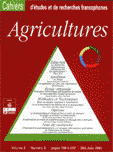"Choanephora cucurbitacearum" Curr., un nouveau champignon pathogène de l'Amarante au Congo
Résumé
Choanephora cucurbitacearum Curr. is a pathogenic fungus causing necrosis on stalks and petioles of Amaranthus in the Congo since 1990. In the vegetable-production centres prospected, the percentage of infected plants varied between 13 % and 74.6 %. Asexual spores (conidia) are the major source of propagation and contamination. They are formed on cabbage debris left over in furrows after the cabbage harvest. During the rainy season, the leaf debris produces conidia which disseminate and contaminate the Amaranthus plants. Artificial inoculation produced symptoms similar to those found under natural conditions, provided the relative humidity was high and a wound had been made on the stalk by an insect bite.Téléchargements
Publié
1993-05-01
Comment citer
Makambila, C., & Goma, J.-B. (1993). "Choanephora cucurbitacearum" Curr., un nouveau champignon pathogène de l’Amarante au Congo. Cahiers Agricultures, 2(3), 217–219 (1). Consulté à l’adresse https://revues.cirad.fr/index.php/cahiers-agricultures/article/view/29791
Numéro
Rubrique
Articles

